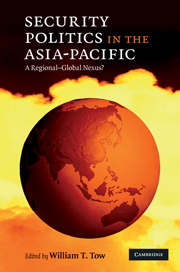Book contents
- Frontmatter
- Contents
- List of illustrations
- About the contributors
- Preface
- Acknowledgements
- List of abbreviations
- 1 Setting the context
- Part I
- Part II
- 6 Hegemony, hierarchy and order
- 7 Democracy and security in East Asia
- 8 Security community-building in the Asia-Pacific
- 9 Human security and global governance
- 10 The economics–security nexus in the Asia-Pacific region
- Part III
- Part IV
- References
- Index
- References
6 - Hegemony, hierarchy and order
Published online by Cambridge University Press: 05 June 2012
- Frontmatter
- Contents
- List of illustrations
- About the contributors
- Preface
- Acknowledgements
- List of abbreviations
- 1 Setting the context
- Part I
- Part II
- 6 Hegemony, hierarchy and order
- 7 Democracy and security in East Asia
- 8 Security community-building in the Asia-Pacific
- 9 Human security and global governance
- 10 The economics–security nexus in the Asia-Pacific region
- Part III
- Part IV
- References
- Index
- References
Summary
Introduction
What can we usefully say about the interplay between ‘global’ and ‘regional’ security structures and dynamics? How does our understanding of the regional–global security nexus help us to analyse the Asian security order and to make projections about future prospects? These two questions guide the discussion in this chapter.
Over the last fifteen years, Asia has experienced greater regionalism in economic and strategic terms than ever before. One might even argue that the development of a new regional power balance sustained by the balancing and engagement strategies of key regional players such as the Association of Southeast Asian Nations (ASEAN) has intensified. In the course of these multilateral efforts, China has become an increasingly central component of the regional order-building process, both because of its increasing economic and military strengths, and as a result of its growing political and institutional influence. Because such positionality has been established in what is the world's wealthiest and arguably its most dynamic region, that country has arguably become the United States' most likely ‘peer competitor’ for the remainder of this century. China's growing power effectively thrusts the Asia-Pacific into a central position to affect the future course of international security.
In this context, the ‘global’ dimension of security is often thought about in terms of the interjection of wider US interests into this geopolitically vital region, juxtaposed against a ‘rising China’.
- Type
- Chapter
- Information
- Security Politics in the Asia-PacificA Regional-Global Nexus?, pp. 101 - 121Publisher: Cambridge University PressPrint publication year: 2009
References
- 1
- Cited by



